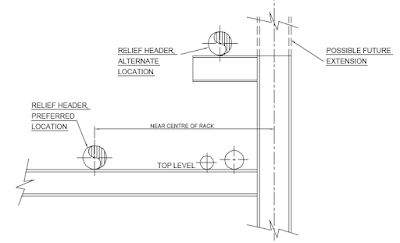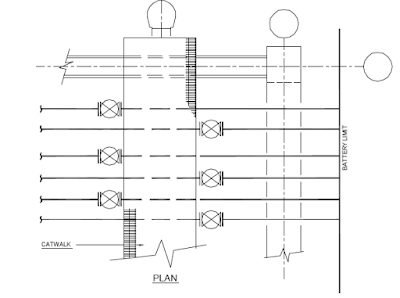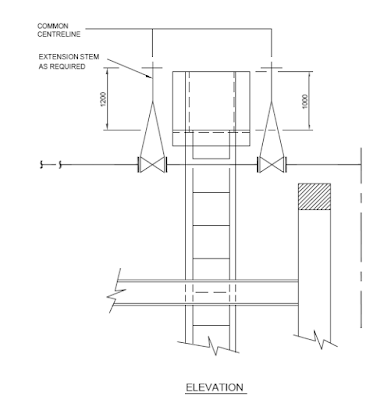The piperack general arrangement
is finalised during the development of overall plot plan. The exact width of
the piperack, numbers of levels and elevations, the access and maintenance
platforms are finalised during piperack piping study.
Normally, the piperack piping
study, with its structural and platform requirements is the first priority item
for detail engineering of a process unit. The piperack may be an integral part
of a process unit located in the middle of the unit or it may be an arterial part
connecting several services of other process unit.
The following data and drawings
are required to be studied before starting the detailed design of piperack
piping study:
Unit Plot Plan / Overall Plot
Plan, Piping and Instrumentation diagrams Plant layout specification, Client
specification, Material of construction, Fireproofing requirements
STEPS TO PIPERACK PIPING
The first step in the development
of any piperack is the generation of a line-routing diagram. A line routing
diagram is a schematic representation of all process piping systems drawn on a
copy of piperack general arrangement drawing / or on the unit plot plan where
the piperack runs in the middle of the process unit.
Based on the information
available on the first issue of P&I Diagram / Process flow diagram i.e.
line size, line number, pipe material, operating temperature etc. the line
routing diagram is to be completed.
Once the routing diagram is
complete, the development of rack width, structural column spacing, road
crossing span, numbers of levels and their elevations should be started.
Piperack column spacing shall be
decided based on the economics of the pipe span as well as the truss
arrangement to accommodate double the span for road crossing or avoiding
underground obstructions.
Piperack arrangement should be
developed to suit the specific plant requirements.
Normally, piperack carry process
lines on the lower level or levels and the utility lines on the top level.
Instrument and electrical trays are integrated on the utility level if space
permits or on a separate level above all pipe levels.
Any piperack design should
provide provision for future growth to the extent of 25 to 30% on the rack
clear width.
When flanges or flanged valves
are required on two adjacent lines, the flanges are to be staggered.
Thermal expansion or contraction
must be accomodated by keeping sufficient clearance at the location where the
movements will occur.
After analysing all the
requirements and arrangements, the dimensions are to be rounded off to the next
whole number. Based on the economics, the width and the number levels e.g. two
tier of 30 ft. wide or three tier of 20 ft. wide rack will be decided.
The gap between the tiers shall
be decided on the basis of the largest diameter pipeline and its branching. The
difference between the bottom line of pipe in the rack and the bottom of a
branch as it leaves the rack shall be decided carefully, to avoid any
interference due to support, insulation, size of branch etc. All branch lines
from the main lines on piperack shall be taken aesthetically on a common top of
steel (TOS).
LOCATION OF VALVES
Various factors shall be
considered while locating each line, valve and instrument in a piperack. In a
standard process unit piperack, process lines are located on the lower levels,
utility lines are on the next higher level and a separate top level is arranged
for electrical and instrument cable trays. The requirements and locations of
electrical and instrument cable trays alongwith their spacing, protective
cover, approach platform / walkways are to be discussed with the electrical and
instrument engineers.
The largest lines should be
located near the supporting columns to reduce the overall load on the
supporting beams.
The relief headers must be
located above the top level of the rack to allow the line to drain to blowdown
drum. The designer should avoid locating pipeline over the centreline of
structural column for support so that the columns can be extended for future
rack expansion.
Shut-off valves at utility
headers are located inside the rack area in the horizontal position directly
above the header. Valves must be accessible from platforms or by chain
operators (chain to fall free of obstructions hampering operation).
Refer sketch.
This view highlights features requiring additional considerations. The width of
the access way is determined by the space needed to maintain the equipment
located at grade below the piperack.
The valves are
staggered on either side of the catwalk and handwheel extension stems are
furnished when necessary to facilitate operation.



You may want to try doing racks out of these pipes too! Trust us its cool. Pipe Rack System
ReplyDeleteI actually wanted to write a small word so as to say thanks to you for those awesome solutions you are showing on this website. My prolonged internet research has at the end of the day been honored with extremely good insight to talk about with my family. I would claim that we readers actually are extremely fortunate to exist in a fabulous place with so many lovely professionals with great solutions. I feel quite blessed to have come across the webpage and look forward to many more excellent moments reading here. Thanks once again for everything.
ReplyDeletemechanical engineering edmonton
Nice Post! Thanks For Sharing. Also visit strong valves & check out Gate Valves, Ball Valves, Butterfly Valves, Check Valves, Control Valves, & Pinch Valves.
ReplyDeleteNice info also check out Alloy 20 Round Bar Manufacturer at Nippon Alloys Inc. We also deal with Sheets and Plates and Pipes and Tubes.
ReplyDeleteThank you for sharing an informative blog. Also Visit-
ReplyDeleteSingle Piece Design Ball Valves
two-piece Design Ball valve
Three piece design Ball Valves
Four Way Ball Valves
This comment has been removed by the author.
ReplyDeleteYour blog is amazing, i really like appreciate the work
ReplyDeletevisit:Inconel X750 Round Bar Supplier in India
Also visit:https://neptunealloys.com/
Thank you for sharing such a wonderful article. You may also like: Pipe fittings suppliers in Saudi Arabia, Pipe fittings suppliers in UAE and Pipe fittings suppliers in Dubai
ReplyDeleteNice info also check out Alloy 20 Round Bar Manufacturer or Alloy 20 Round Bar Manufacturers at Nippon Alloys Inc. We also manufacture products like Fillers Wire and Forged Circle and Rings.
ReplyDeleteIt's a really informative post. You may also check out blog on Titanium Tank, Titanium Vessel Manufacturer in India, Titanium Butterfly Valve, Titanium Ball Valve in India or Visit the website Ladhani Metal Corporation.
ReplyDeleteThis comment has been removed by the author.
ReplyDeleteThis comment has been removed by the author.
ReplyDeleteExcellent Post, Also read our blogs on Fasteners Manufacturers,High Tensile Fasteners Manufacturer, Inconel Fasteners Manufacturer, Monel Fasteners Manufacturer, also visit Ananka Fasteners
ReplyDeleteRenine Metalloys LLP is a trustworthy Inconel 600 supplier & Manufacturer of all Inconel products. Contact us for more details on the Inconel 600 fasteners price.
ReplyDelete